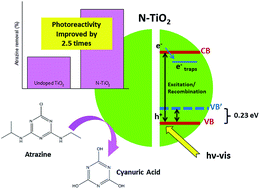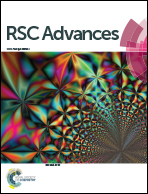Controlled nitrogen insertion in titanium dioxide for optimal photocatalytic degradation of atrazine
Abstract
Introducing defects into the intrinsic TiO2 structural framework with nitrogen enhanced the photocatalytic response towards the degradation of atrazine, as compared to undoped TiO2. Both catalysts, which were prepared in an analogous manner, demonstrated high crystallinity and anatase phase dominant with well defined {101} facets, which serves as a pioneer platform for good photocatalytic activity. The introduction of nitrogen increased the stability of the crystal structure which leads to the formation of pure active anatase phase. Although the optical response was shifted towards the visible region, initiated by the formation of new absorption defects and interstate energy levels, the chemical state of nitrogen in the doped TiO2 controls the overall catalyst photoreactivity. In this study, it was found that the surface area and degree of band gap reduction played a lesser role for photocatalysis enhancement, although they partly contributed, than the concentration of surface charge traps and the type of structural framework formed during nitrogen incorporation. The enhancement in the photocatalytic degradation of atrazine clearly was influenced by the loading and nature of the nitrogen dopant, which in turn, governed the types of chemical and optical properties of the final catalyst product.


 Please wait while we load your content...
Please wait while we load your content...